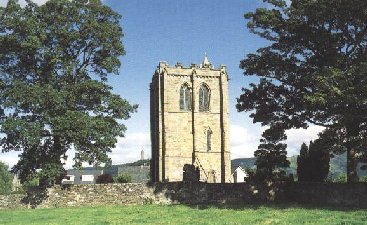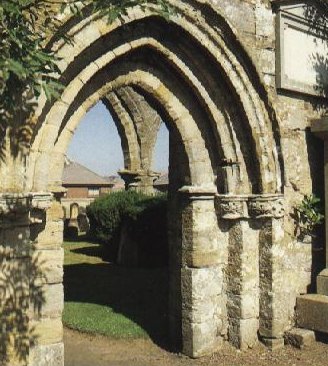Wallace
the Guerilla
| William Wallace was the son of
Sir Malcolm Wallace, the Laird of Elderslie, which is now
a district of Paisley. At one time in his youth he lived
with his uncle who was a cleric at Cambuskenneth Abbey
outside Stirling. He grew up to be a fine strong land
over 6ft tall, a giant among men in those times. A a
second son with no land of his own, he was possibly
rather wild, with a fiery temper which he was later to
vent on the English. It was in Dundee that the first
recorded afray took place between Wallace and Selby, the
son of the English constable of Dundee Castle. It is
quite likely that this event took place in December 1291.
Furious at his taunts, Wallace stuck his dirk into
Selby's heart and escaped into he crowd on onlookers. |
|

Cambuskenneth
Abbey, where Wallace lived as a boy
|
There were to be other tales of his
becoming embroiled with Englishmen, and singel-handedly
despatching several at a time. His reputation as an anti-English
firebrand attracted a small band of like-minded men with whom he
lived a will-o'-the wisp life in the South West of the country.
Eventually at Louden Hill in the Irvine Valley he ambushed
Fenwick, the Kninght who had killed his father. It is said that
although Wallace only had 50 men against 200 soldiers, Fenwick
was killed and the English scattered, leaving 100 dead
altogether, along with a large number of useful armour, weapons
and horses. Wallace was subsequently declared an outlaw; this is
thought to have happened around the time of Balliol's humiliating
defeat by Edward in 1296.
 |
|
After Loudoun, Wallace and his
compatriots retreaed into Etterick Forest, a large and
impenetrable area without roads in which no army would
dare move nor cvalry scouts enter. On its pheriphery were
the towns of Selkirk, Moffat and Lanark, and it was in
the latter that Wallace secretly courted Marion
Baraidfute, a beautful young heiress. They may have been
married in St kentigern's, the now ruined parish church,
but her is no proof of that, nor that she bore him a
daughter. What is known is that the Sheriff of Lanark,
Hazelrig, had had her brother put to death. To avenge
him, Wallace stole into town with some comrades and,
after killing about 50 English soldiers, hid in Marion's
house before fleeing back to the safety of the forest.
Hazelrig, having failed to capture Wallace, executed the
innocent Marion instead 'to deny Wallace of the woman he
truely loved'. It was probably the biggest mistae any
sheriff made. Wallace gathered a large force and again
crept into the town under darkness, overpowered the
castle guards and killed Hazrlrig in his bed, then struck
down his son and 240 English soldiers, merchants and
commoners, sparing only their women and priests - a
luxury not afforded the people of Berwick by Edward. |
| The ruins of St
Kentigern's Church, where Wallace is thought to have
married Marion |
|
|
News of the slaughter lit the fire of independence among the
people and thousands joined Wallace's crusade. In a bold atttack
they took Scone and overran the neighbouring country. With
Wallace currently in the ascendancy, he was joined by several
nobles including the young Robert Bruce, who was destined to take
up Wallace's cause after his death and eventually restore the
Scottish crown. Soon most of the country was in revolt, and
Edward ordered Sir Henry de Percy and Sir Robert de Clifford to
restore order. They raised an army in the north and marched into
Scotland via Annandale and Nithsdale to confront the Scots at
Irvine. At this point the Scottish nobles decided that because
Wallace was a plebian they could no longer serve him, and all but
Sir Andrew Moray of Bothwell promptly surendered to the English
commanders. Not so the common people. They literally rampaged
across Scotland, bewildering the English with their guerilla
tactics and taking every castle in their path until they
confronted the main English army outside Stirling.
The Battle of Stirling Bridge -
1297
back to History index
HOME
This
page created on 17th April, 2000

